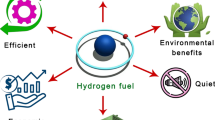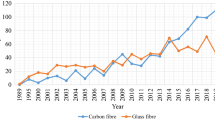Abstract
The present study aims to develop and implement data-driven machine learning (ML) models for performance prediction of heat flow and specific heat of sustainable composite phase change materials (SCPCMs). The implementation of ML models is being investigated for the first time, though the usage of PCMs has been studied in many applications. In this work, five ML models, namely decision tree regression (DTR), k-nearest neighbour (k-NN), random forest regression (RFR), extreme gradient boosting regression (XGBR), and cat boost regression (CBR), are considered for predicting the heat flow and specific heat of SCPCMs. A total of 14,303 data points for heat flow and 9059 data points for specific heat are considered. Five input parameters are considered: concentration of PCM, the concentration of biochar, concentration of multi-walled carbon nanotubes (MWCNT), heating rate of the sample, and temperature of the sample. The output parameters are heat flow (mW mg−1) and specific heat (J g−1 °C−1). From the results of performance predictions, the k-NN model exhibited the best coefficient of determination of 0.997 and 0.994 for heat flow and specific heat, respectively, among its peers. A model sensitivity analysis for heat flow prediction is performed and found that the errors between the actual and predicted values are 1.79%, 3.41%, 1.16%, 14.95%, and 1.66% for RFR, DTR, k-NN, XGBR, and CBR, respectively. Similarly, for the specific heat prediction, the error between the actual and predicted values is 0.687%, 0.99%, 0.37%, 10%, and 0.44% for RFR, DTR, k-NN, XGBR, and CBR, respectively. Thus, the developed data-driven machine learning models can be graded as k-NN > CBR > RFR > DTR > XGBR, based on their prediction accuracy and are found to be helpful in the selection of suitable sustainable PCMs for latent heat thermal energy storage systems.















Similar content being viewed by others
References
World Energy Outlook 2020.
World Energy Outlook 2021.
Yuan K, Shi J, Aftab W, Qin M, Usman A, Zhou F, et al. Engineering the thermal conductivity of functional phase-change materials for heat energy conversion. Storage Util. 2019;1904228:1–31.
Advanced Science - 2020 - Huang - phase‐changing microcapsules incorporated with black phosphorus for efficient solar.pdf.
Hyun DC, Levinson NS, Jeong U, Xia Y. Emerging applications of phase-change materials (PCMs): teaching an old dog new tricks. Angew Chem Int Ed. 2014;53:3780–95.
Luo J, Zou D, Wang Y, Wang S, Huang L. Battery thermal management systems (BTMs) based on phase change material (PCM): a comprehensive review. Chem Eng J. 2022;430:132741. https://doi.org/10.1016/j.cej.2021.132741.
Xu H, Wang N, Zhang C, Qu Z, Karimi F. Energy conversion performance of a PV/T-PCM system under different thermal regulation strategies. Energy Convers Manage. 2021;229: 113660.
Rakshamuthu S, Jegan S, Benyameen JJ, Selvakumar V, Anandeeswaran K, Iyahraja S. Experimental analysis of small size solar dryer with phase change materials for food preservation. J Energy Storage. 2021;33:102095. https://doi.org/10.1016/j.est.2020.102095.
Browne MC, Norton B, McCormack SJ. Phase change materials for photovoltaic thermal management. Renew Sustain Energy Rev. 2015;47:762–82. https://doi.org/10.1016/j.rser.2015.03.050.
Du K, Calautit J, Wang Z, Wu Y, Liu H. A review of the applications of phase change materials in cooling, heating and power generation in different temperature ranges. Appl Energy. 2018;220:242–73. https://doi.org/10.1016/j.apenergy.2018.03.005.
Pandey AK, Hossain MS, Tyagi VV, Abd Rahim N, Selvaraj JAL, Sari A. Novel approaches and recent developments on potential applications of phase change materials in solar energy. Renew Sustain Energy Rev. 2018;82:281–323. https://doi.org/10.1016/j.rser.2017.09.043.
Kalnæs SE, Jelle BP. Phase change materials and products for building applications: a state-of-the-art review and future research opportunities. Energy Build. 2015;94:150–76. https://doi.org/10.1016/j.enbuild.2015.02.023.
Solé A, Miró L, Barreneche C, Martorell I, Cabeza LF. Review of the T-history method to determine thermophysical properties of phase change materials (PCM). Renew Sustain Energy Rev. 2013;26:425–36. https://doi.org/10.1016/j.rser.2013.05.066.
Drissi S, Eddhahak A, Caré S, Neji J. Thermal analysis by DSC of phase change materials, study of the damage effect. J Build Eng. 2015;1:13–9. https://doi.org/10.1016/j.jobe.2015.01.001.
Rolka P, Przybylinski T, Kwidzinski R, Lackowski M. The heat capacity of low-temperature phase change materials (PCM) applied in thermal energy storage systems. Renew Energy. 2021;172:541–50. https://doi.org/10.1016/j.renene.2021.03.038.
Shi J, Chen Z, Shao S, Zheng J. Experimental and numerical study on effective thermal conductivity of novel form-stable basalt fiber composite concrete with PCMs for thermal storage. Appl Therm Eng. 2014;66:156–61. https://doi.org/10.1016/j.applthermaleng.2014.02.012.
Faheem A, Ranzi G, Fiorito F, Lei C. A numerical study on the thermal performance of night ventilated hollow core slabs cast with micro-encapsulated PCM concrete. Energy Build. 2016;127:892–906. https://doi.org/10.1016/j.enbuild.2016.06.014.
Buonomo B, Celik H, Ercole D, Manca O, Mobedi M. Numerical study on latent thermal energy storage systems with aluminum foam in local thermal equilibrium. Appl Therm Eng. 2019;159:1368–80. https://doi.org/10.1016/j.renene.2022.06.122.
Mesalhy O, Lafdi K, Elgafy A, Bowman K. Numerical study for enhancing the thermal conductivity of phase change material (PCM) storage using high thermal conductivity porous matrix. Energy Convers Manage. 2005;46:847–67.
Kim S, Kim S, Paek S, Jeong SG, Lee JH. Thermal performance enhancement of mortar mixed with octadecane/xGnP SSPCM to save building energy consumption. Solar Energy Mater Solar Cells. 2014;122:257–63. https://doi.org/10.1016/j.solmat.2013.12.015.
Sharma A, Tyagi VV, Chen CR, Buddhi D. Review on thermal energy storage with phase change materials and applications. Renew Sustain Energy Rev. 2009;13:318–45.
Wang Z, Wang Y, Zeng R, Srinivasan RS, Ahrentzen S. Random Forest based hourly building energy prediction. Energy Build. 2018;171:11–25. https://doi.org/10.1016/j.enbuild.2018.04.008.
Ahmad T, Chen H, Guo Y, Wang J. A comprehensive overview on the data driven and large scale based approaches for forecasting of building energy demand: a review. Energy Build. 2018;165:301–20. https://doi.org/10.1016/j.enbuild.2018.01.017.
Li K, Xie X, Xue W, Dai X, Chen X, Yang X. A hybrid teaching-learning artificial neural network for building electrical energy consumption prediction. Energy Build. 2018;174:323–34. https://doi.org/10.1016/j.enbuild.2018.06.017.
Bhamare DK, Saikia P, Rathod MK, Rakshit D, Banerjee J. A machine learning and deep learning based approach to predict the thermal performance of phase change material integrated building envelope. Build Environ. 2021;199:107927. https://doi.org/10.1016/j.buildenv.2021.107927.
Oliynyk AO, Antono E, Sparks TD, Ghadbeigi L, Gaultois MW, Meredig B, et al. High-throughput machine-learning-driven synthesis of full-Heusler compounds. Chem Mater. 2016;28:7324–31.
Gaultois MW, Oliynyk AO, Mar A, Sparks TD, Mulholland GJ, Meredig B. Perspective: web-based machine learning models for real-time screening of thermoelectric materials properties. APL Mater Doi. 2016;10(1063/1):4952607.
Muthya Goud V, Raval F, Ruben SD. A sustainable biochar-based shape stable composite phase change material for thermal management of a lithium-ion battery system and hybrid neural network modeling for heat flow prediction. J Energy Storage. 2022;56:106163.
Mg V, Rs D. A comprehensive investigation and artificial neural network modeling of shape stabilized composite phase change material for solar thermal energy storage. J Energy Storage. 2022;48:103992. https://doi.org/10.1016/j.est.2022.103992.
Kanimozhi B, Ramesh Bapu BR, Pranesh V. Thermal energy storage system operating with phase change materials for solar water heating applications: DOE modelling. Appl Therm Eng. 2017;123:614–24. https://doi.org/10.1016/j.applthermaleng.2017.05.122.
Ermis K, Erek A, Dincer I. Heat transfer analysis of phase change process in a finned-tube thermal energy storage system using artificial neural network. Int J Heat Mass Transf. 2007;50:3163–75.
Priyadarshi G, Baruah D, Naik BK. Design and performance prediction of desiccant coated heat exchanger using ANFIS: AI tool and dynamic model. Appl Therm Eng. 2022. https://doi.org/10.1016/j.applthermaleng.2022.119034.
Shapi MKM, Ramli NA, Awalin LJ. Energy consumption prediction by using machine learning for smart building: case study in Malaysia. Dev Built Environ. 2021;5:100037. https://doi.org/10.1016/j.dibe.2020.100037.
Marani A, Nehdi ML. Machine learning prediction of compressive strength for phase change materials integrated cementitious composites. Constr Build Mater. 2020;265:120286. https://doi.org/10.1016/j.conbuildmat.2020.120286.
Tejes PKS, Gembali C, Kiran NB. Astarag Mohapatra design and performance analyses of evacuated U-tube solar collector using data-driven machine learning models. 2022 [cited 2022 Nov 27]; Available from: http://asmedigitalcollection.asme.org/solarenergyengineering/article-pdf/145/1/011007/6900805/sol_145_1_011007.pdf
Pedregosa F, Varoquaux G, Gramfort A, Michel V, Thirion B, Grisel O, et al. Scikit-learn: machine learning in Python. J Mach Learn Res. 2011;12:2825–30.
Fikri MA, Pandey AK, Samykano M, Kadirgama K, George M, Saidur R, et al. Thermal conductivity, reliability, and stability assessment of phase change material (PCM) doped with functionalized multi-wall carbon nanotubes (FMWCNTs). J Energy Storage. 2022;50:104676. https://doi.org/10.1016/j.est.2022.104676.
Dhamodharan P, Bakthavatsalam AK. Experimental investigation on thermophysical properties of coconut oil and lauryl alcohol for energy recovery from cold condensate. J Energy Storage. 2020;31:101639. https://doi.org/10.1016/j.est.2020.101639.
Author information
Authors and Affiliations
Contributions
VMG was involved in conceptualization, data curation, formal analysis, investigation, methodology, validation, visualization, software, writing—original draft, and writing—review and editing. RSD was involved in conceptualization, formal analysis, investigation, methodology, project administration, resources, software, supervision, validation, visualization, writing—original draft, and writing—review and editing.
Corresponding author
Additional information
Publisher's Note
Springer Nature remains neutral with regard to jurisdictional claims in published maps and institutional affiliations.
Rights and permissions
Springer Nature or its licensor (e.g. a society or other partner) holds exclusive rights to this article under a publishing agreement with the author(s) or other rightsholder(s); author self-archiving of the accepted manuscript version of this article is solely governed by the terms of such publishing agreement and applicable law.
About this article
Cite this article
Vempally, M.G., Dhanarathinam, R.S. Design and selection of suitable sustainable phase change materials for latent heat thermal energy storage system using data-driven machine learning models. J Therm Anal Calorim 148, 10697–10712 (2023). https://doi.org/10.1007/s10973-023-12426-4
Received:
Accepted:
Published:
Issue Date:
DOI: https://doi.org/10.1007/s10973-023-12426-4




